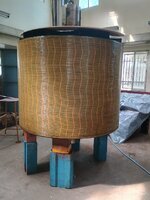We ran a 490 V, 2095 KW, 3000 A, 100 RPM Permanent Magnet rotor motor on no-load via a VFD.
In open loop, the motor no-load current is 210 amps while in closed loop (with shaft mounted encoder), it is only 16 Amps.
Why this vast difference between open loop and closed loop currents?
Edit: It's a PM synch motor. Frequency 53.3 Hz. Would this be the reason for such a vast difference between open loop and closed loop currents?
In open loop, the motor no-load current is 210 amps while in closed loop (with shaft mounted encoder), it is only 16 Amps.
Why this vast difference between open loop and closed loop currents?
Edit: It's a PM synch motor. Frequency 53.3 Hz. Would this be the reason for such a vast difference between open loop and closed loop currents?
Last edited:

